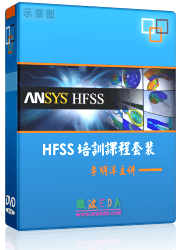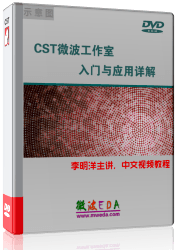Eigenmode Solver Parameters
 Solver
Solver  Start Simulation Start Simulation  Eigenmode Solver Eigenmode Solver
If you are not familiar with what the eigenmode solver does and what
it is used for, you should first read the Solver Overview
or the Eigenmode
Solver Overview.
The eigenmode solver allows the calculation of resonant modes for loss free structures without
open or conduction wall boundary conditions, and structures with
electric/magnetic losses provided that the assumption of a frequency independent
complex permittivity or reluctivity is valid. Before you start the solver
you should have made all necessary solver
settings. After the simulation has finished, the calculated modes
are listed in the result window. The field patterns can be accessed through
the
in 2D/3D Results  Modes. Modes.
Solver settings frame
Mesh type:
The eigenmode solver offers a hexahedral
mesh as well as a tetrahedral
mesh for the discretization of the computation domain.
Method:
For the hexahedral
mesh two different eigenmode solver methods are provided, namely AKS (Advanced Krylov Subspace) and
JDM (Jacobi-Davidson Method).
Please note, that the latter is capable to handle also electrically or
magnetically lossy problems by considering frequency independent complex
permittivity or reluctivity values, as discussed in the Eigenmode
Solver Overview.
Modes:
In this field, you may specify the number of modes to be calculated. The
eigenmode solver will always calculate the resonant modes with the lowest
frequencies. If the JDM eigenmode solver method
is selected you have the possibility either to automatically calculate
all modes from the lower frequency to the upper frequency limit by activating
the corresponding radio button Choose
number of modes automatically (fmin...fmax). This option is designed
to ensure that all modes in the given frequency band are found, without
the need to subsequently increase the number of modes to calculate. Or
you can activate the radio button Frequencies
above, which allows you to enter a lower limit to the modes' frequencies.
Admissible values are zero to the maximum frequency of the frequency range.
The eigenmodes above this frequency are then calculated in ascending order.
Store all result
data in cache: Check here if you want the solver results to be
stored in the result
data cache. The efficient usage of the result data cache is explained
in the printed documentation "Advanced
Topics".
Q-factor calculation frame
Calculate external
Q-factor: If this check button is activated the external Q-factor
will be automatically calculated after the eigenmode solver run. This
option requires Consider losses in postprocessing
only to be active.
Consider losses
in postprocessing only: It is common practise for Eigenmode calculations
to ignore the losses in a first step, namely for the calculation of the
Eigenmode solutions themselves. An approximate consideration of the losses
is still possible in the post processing however, by assuming that the
losses generated on the boundary can be calculated from the loss-free
case. This approach, also referred to as perturbation method, speeds up
the calculation.
If Consider losses
in postprocessing only is deactivated, the JDM solver with hexahedral
mesh and the Eigenmode solver with tetrahedral mesh may consider material
losses to some extent, as described above. Q-factors for resonant structures
can be calculated directly in that way.
However, by activating this check button the solver
is forced to solve the loss-free problem, similar to the Simplify
Model settings for the material treatment in the solvers. But using
Consider losses in postprocessing only
instead of "Simplify Model", the Q-factor can be calculated
afterwards by means of perturbation analysis as a post processing step.
Please note that the AKS solver only solves loss-free
problems, so that the perturbation analysis is automatically performed
to receive Q-factor information. Consequently the check button is disabled
for this solver type.
Adaptive mesh refinement frame
Enable:
Mark this check box to activate the adaptive mesh refinement. The mesh
will be modified by successively changing the settings of the mesh expert
system. Press the Properties...
button to edit the current settings for the mesh
refinement.
Start
Store the specified settings and start the calculation
of the resonant modes.
Optimize...
This button brings you into the Optimize
dialog box that allows you to set up and start an optimization run.
Parameter Sweep...
This button opens the Parameter
Sweep dialog box that allows you to set up and start a sequence of
parameterized simulations. Note that it is necessary for the model to
contain parameterized structure elements or solver settings.
Acceleration...
Opens the acceleration
dialog box to control the high performance options of the simulation
run (e.g. GPU acceleration, Distributed Computing, MPI).
Specials...
This button either opens the Eigenmode
Solver Specials Dialog (AKS), the Eigenmode
Solver Specials (JDM), or the Eigenmode
Solver Specials (Tetrahedral). Here you can specify some special settings
concerning the eigenmode solver with the selected method.
Simplify Model...
Opens the simplify
model dialog.
Apply
Store the specified settings without starting the
calculation.
Close
Closes this dialog box without performing any further
action.
Help
Shows this help text.
See also
Solver
Overview, Eigenmode
Solver Overview, Eigenmode
Solver Settings, Eigenmode
Solver Specials (AKS), Eigenmode
Solver Specials (JDM), Eigenmode
Solver Specials (Tetrahedral), Optimize
Parameters, Parameter
Sweep, Distributed
Computing Overview.




HFSS视频教程
ADS视频教程
CST视频教程
Ansoft Designer 中文教程
|